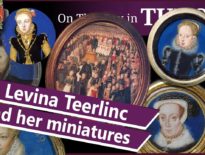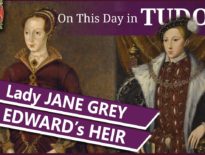On this day in Tudor history, the night of 22nd June 1509, King Henry VIII rewarded twenty-six men for their loyal service to the crown by making them Knights of the Bath as part of the celebrations for his coronation.
One of the men honoured for his service to the crown was Thomas Boleyn, father of the future queen, Anne Boleyn. But what had he done to deserve this honour? Find out more about Thomas Boleyn's rise at the court of Henry VII, and how he was a royal favourite long before his daughters became involved with the king, in today's talk.
Also on this day in Tudor history, 22nd June 1528, Mary Boleyn, sister of Anne Boleyn, was widowed when her first husband, William Carey, died during the Sweating Sickness epidemic of 1528. His death had a major impact on Mary's situation and you can find out more in last year’s video:
May 30 - Knights of the Bath for Anne Boleyn's coronation:
Thomas and Elizabeth Boleyn:
March 12 - The death of Thomas Boleyn, father of Anne Boleyn:
Also on this day in history:
- 1477 – Birth of Thomas Grey, 2nd Marquis of Dorset, courtier and constable of Warwick Castle and of Kenilworth Castle. He was the third son and heir of Thomas Grey, first Marquis of Dorset, and his wife, Cicely.
- 1535 - John Fisher, Bishop of Rochester, was beheaded. He was beatified in 1886 by Pope Leo XIII and then canonised in 1935 by Pope Pius XI. His feast day is celebrated today, the 22nd June, a feast day which he shares with his friend Thomas More. He is seen as a Catholic martyr because he died for his beliefs.
- 1536 - Henry VIII’s eldest daughter, Mary, finally submitted to her father and accepted her father as Supreme Head of the Church in England and the invalidity of her parents' marriage.
- 1547 – Death of George Lokert (or Lockhart), Dean of Glasgow, logician and theologian. Lokert studied at the University of Paris and was prior of the Collège de Sorbonne.
- 1557 – Death of Richard Woodman, Protestant martyr. He was burnt at Lewes, in Sussex, with nine other martyrs after he refused to recant.
- 1559 – Publication of Queen Elizabeth I’s Prayer Book.
- 1599 – Death of Sir William Fitzwilliam, Lord Deputy of Ireland in Elizabeth I's reign, at Milton, Northamptonshire, after a long illness. He was buried at the church of Marham, Norfolk.
Transcript:
On this day in Tudor history, the night of 22nd June 1509, King Henry VIII rewarded twenty-six men for their loyal service to the crown by making them Knights of the Bath as part of the celebrations for his coronation.
The men were Robert Radcliffe, Baron Fitzwalter; Henry Scrope, 7th Baron Scrope of Bolton; Lord Fitzhugh; William Blount, 4th Baron Mountjoy; Henry Daubeney, 1st Earl of Bridgewater and 2nd Baron Daubeney; Thomas Brooke, 8th Baron Cobham; Henry Clifford, 1st Earl of Cumberland; Sir Maurice Berkeley, de jure 4th Baron Berkeley; Sir Thomas Knyvet; Andrew Windsor, 1st Baron Windsor; Sir Thomas Parr (father of Catherine Parr); Sir Thomas Boleyn (father of Anne Boleyn); Sir Richard Wentworth; Sir Henry Ughtred; Sir Francis Cheyney; Sir Henry Wyatt (father of poet and diplomat Sir Thomas Wyatt the Elder); Sir George Hastings, 1st Earl of Huntingdon; Sir Thomas Metham; Sir Thomas Bedingfield; Sir John Shelton (Thomas Boleyn’s brother-in-law); Sir Giles Alington; Sir John Trevanion; Sir William Crowmer; Sir John Heydon (his mother was a Boleyn); Sir Goddard Oxenbridge; and Sir Henry Sacheverell or Sackveyle.
The men were dubbed Knights of the Bath at a special ceremony at the Tower of London, and you can find out about what would happen in this ceremony in my video on the Knights of the Bath for Anne Boleyn’s coronation, and I’ll give you a link to that.
As you will have noticed, two of Henry VIII’s future father-in-laws were made Knights of the Bath, and I just wanted to draw attention to Thomas Boleyn being featured here. It is often said that Thomas Boleyn only rose at court because of his two daughters’ relationships with the king, but this honour was in 1509, when his daughters were little girls at home at Hever Castle.
Thomas began his court career under King Henry VII and being made a Knight of the Bath was a reward for his loyal service to the previous king. In 1497, with his father, William Boleyn, Thomas had fought on the king’s side against the rebels of the Cornish Rebellion at the Battle of Blackheath. In 1501, he was present at the wedding of Prince Arthur and Catherine of Aragon, and in 1503, he was a member of the party of men who escorted Margaret Tudor, Henry VII’s daughter, to Scotland to marry King James IV, and he was appointed an esquire of the body before the king’s death, and kept that position when Henry VIII came to the throne in April 1509.
He went on to serve King Henry VIII as a diplomat, carrying out incredibly important embassies, and by 1514, again before either of his daughters was linked to the king, he owned or had been granted the controlling interest in around twenty manors, and had other grants and offices. He was a very important man, a skilled diplomat and a royal favourite, and he’d continue to be so, being granted more manors and important offices, until the falls of his son and daughter in the spring of 1536. I’ll give you links to my other videos on Thomas who has been badly maligned by fiction and TV. The real Thomas is very different.



Leave a Reply